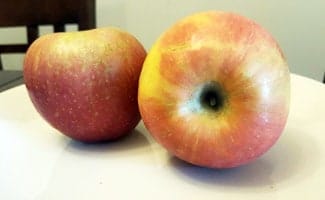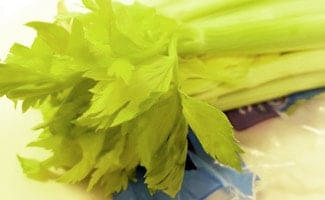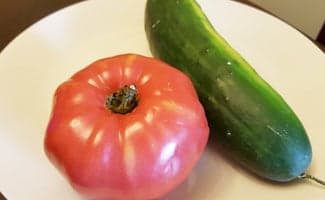The Dirty Dozen: What to Buy Organic and What Not
 I’ve been working on cleaner eating for a while, but because we were still eating out more often than I care to admit, I hadn’t really worked hard to include organic foods in our budget. I bought organic when the prices weren’t that different (like with carrots), but I, honestly, sort of chose to ignore the dangers lurking on the regular produce shelves. Recently, I started hearing about grapes from a few friends. It’s sort of a no brainer that any fruit or veggie that you eat the skin of is probably best in the organic variety since it is directly exposed to pesticides. Twice over the last month, I heard that because grapes skins are so thin, the pesticides can seep all the way through the grape. This is scary since I know pesticides have been linked to many different conditions and even cancer. That’s definitely not ideal.
I’ve been working on cleaner eating for a while, but because we were still eating out more often than I care to admit, I hadn’t really worked hard to include organic foods in our budget. I bought organic when the prices weren’t that different (like with carrots), but I, honestly, sort of chose to ignore the dangers lurking on the regular produce shelves. Recently, I started hearing about grapes from a few friends. It’s sort of a no brainer that any fruit or veggie that you eat the skin of is probably best in the organic variety since it is directly exposed to pesticides. Twice over the last month, I heard that because grapes skins are so thin, the pesticides can seep all the way through the grape. This is scary since I know pesticides have been linked to many different conditions and even cancer. That’s definitely not ideal.
Every year, the USDA tests all produce for consumption safety. The Environmental Working Group is a private organization who then compiled and released a list of the “dirtiest” and the “cleanest” conventional produce. Those with more pesticide residue, or more dangerous residue, make a list labeled The Dirty Dozen. Delving deeper into the list proved very educational for me, and played a large part in “changing my ways”. My quest for a healthier life is the driving force behind my shopping decisions these days. Mathematically, choosing organic on those items that we actually eat that made the list will cost a whole whopping $40 more a month if we buy these items every week. Chances are the reality is that it will be more like $20 because I like to change things up. That’s doable on many budgets (I concede not all, but really, there’s likely SOMETHING you can cut out to make up $20-$40 a month and live a longer, healthier life). And, if you skip a meal or two out, which is less healthy in most cases anyway, you will easily find extra room in your budget.
In August, we committed to not spending any money other than groceries, bills and gas for 30 days. No eating out. No junk we don’t need. No little projects that I start and don’t finish (But, MAYBE I’ll actually finish the ones I bought the stuff for months, or years, ago!). I figured it was a good time to really delve into which produce is the worst when it comes to pesticide residue – known as The Dirty Dozen and, conversely, which are the best/least risky. While this information is pretty easily accessible, the reasons behind WHY exactly these items are on the list have to be dug for. I figured I’d make it a little easier to find it all in one place. So, here we go!.
Download the EWG Dirty Dozen iOS App
Most Toxic Produce
1. Strawberries
Because strawberries sit close to the ground and have large leaves, they are often sprayed with fungicide. Strawberries don’t have a smooth surface, so, even with washing, it is hard to get all of the residue off. Studies have also shown that organic strawberries have significantly higher antioxidant levels than conventional! So, although organic strawberries don’t tend to be as bright red and “pretty” as conventional, don’t let this fool you. They are actually healthier beyond just the fungicide residue found on them.
Pricing: Organic vs. “Normal” Strawberries
The cost difference on strawberries was much larger, but I have noticed that organic strawberries go on sale pretty often. The conventional were on sale this week, so they were $2.50 as compared to $4.99 for organic. Strawberries are typically only bought in season when they are on sale at our house anyway, so, as a treat, paying a bit more isn’t a huge deal since it’s only once in a while.
2. Apples
 According to the USDA, 99% of the over 700 apples tested had pesticide residue present. Since it’s pretty common knowledge that the skin of the apple is full of fiber, you really should eat it. But, who wants to eat bug spray? Not I! If you buy conventional apples, you likely are eating pesticides designed to kill. Will they kill you when you take a bite? No, obviously not. However, apples are commonly sprayed with Syngenta‘s Paraquat, a pesticide with a possible link to Parkinson’s disease.
According to the USDA, 99% of the over 700 apples tested had pesticide residue present. Since it’s pretty common knowledge that the skin of the apple is full of fiber, you really should eat it. But, who wants to eat bug spray? Not I! If you buy conventional apples, you likely are eating pesticides designed to kill. Will they kill you when you take a bite? No, obviously not. However, apples are commonly sprayed with Syngenta‘s Paraquat, a pesticide with a possible link to Parkinson’s disease.
Pricing: Organic vs. “Normal” Apples
I checked prices at both Kroger and Walmart. Conventional apples range from 99 cents a pound for your generic red and golden delicious to $2.99 a pound for the more exotic (and better tasting!) varieties like Pink Lady or Honey Crisp. Organic apples ranged from $1.99 a pound for the generic options and $3.59 for the higher end varieties. I will say, neither store had much in the way of availability for the higher end apples that taste so yummy, so this may be a good farmer’s market or Whole Foods/The Fresh Market/Other organic specialty store purchase. Organic apples make up only about 6% of the apples out there, so they are just a little harder to find. I love apples and eat 2-3 a week when we have them. For me, it’s worth an extra 50 cents per apple.
3. Nectarines
Nectarines are, essentially, peaches with smooth skin. It shouldn’t be too surprising that 97% of nectarines had traces of pesticides. The percent is likely just slightly lower because the smooth skin is easier to wash then the fuzzy skin of the peach. When tested by the USDA, 62 different pesticides were found on nectarines. Eight of these are known carcinogens. According to What’s on my food?, the biggest offender was conventional domestic nectarines. 70% of tested conventional nectarines contained Fludioxonil (a known carcinogen). 9.1% of domestic organic nectarines contained it as well, but at an extremely low level (35.9 micrograms per 3.5 ounces in conventional v. 0.03 micrograms in the same amount of organic). Honestly, both levels are pretty low. However, long-term effects aren’t known and these are dangerous chemicals. It’s a case of better safe than sorry.
Pricing: Organic vs. “Normal” Nectarines
The price difference here, again based on a call was $1.99 at Kroger and $2.49 at Whole Foods, a pretty minimal difference per peach.
4. Peaches
I live in Georgia, the peach state. Fun fact, South Carolina actually produces more peaches. Georgia’s largest grossing fruit crop is blueberries and we produce more nuts and cotton than peaches as well. However, Georgia peaches are plentiful and yummy. The good news is they are easy to find at roadside stands by farmers who claim they use no pesticides. The bad news is, there’s no way to confirm this because they aren’t certified. And, since 98% of peaches tested had pesticide residue present, it’s kind of important to know what has been on these peaches.
Pricing: Organic vs. “Normal” Peaches
Honestly, my local grocery stores didn’t have organic peaches. A quick call to Whole Foods was pretty simple though. Peaches are in season right now (early August) and are only 99 cents per pound at Kroger and $1.49 at Publix. At Whole Foods, they assured me they were currently selling local peaches (so, this will vary regionally) and the price is currently a low $1.99 per pound there.
5. Celery
 Celery is one of the easiest on the list to find in the organic variety. It may be simply that there is only one variety of celery and it keeps well, unlike apples and peaches that bruise easily. Celery is a common “diet” food. It is a zero calorie. (I’ve even heard rumors that because it is zero calories, you actually burn calories while eating it. I’m sure it’s minimal, but it sounds good, right?) The problem is it doesn’t have much taste, so it’s usually topped with not so low-calorie items like peanut butter or ranch dressing. However, organic celery actually tastes better than conventional! That doesn’t mean I’ll be eating it by the truckload, but it’s better, which means even if I top it, I’m not loading it up with as much of the bad stuff. According to What’s on my Food?, 100% of conventional celery contained Chlorantraniliprole, an insecticide. No long-term testing has been done on this pesticide. However, the fact that it clings so strongly to celery is a bit disconcerting to me.
Celery is one of the easiest on the list to find in the organic variety. It may be simply that there is only one variety of celery and it keeps well, unlike apples and peaches that bruise easily. Celery is a common “diet” food. It is a zero calorie. (I’ve even heard rumors that because it is zero calories, you actually burn calories while eating it. I’m sure it’s minimal, but it sounds good, right?) The problem is it doesn’t have much taste, so it’s usually topped with not so low-calorie items like peanut butter or ranch dressing. However, organic celery actually tastes better than conventional! That doesn’t mean I’ll be eating it by the truckload, but it’s better, which means even if I top it, I’m not loading it up with as much of the bad stuff. According to What’s on my Food?, 100% of conventional celery contained Chlorantraniliprole, an insecticide. No long-term testing has been done on this pesticide. However, the fact that it clings so strongly to celery is a bit disconcerting to me.
Pricing: Organic vs. “Normal” Celery
Conventional celery ranged from $1.39 a bunch to $2.19 (if you bought the already chopped and bagged type) at Walmart and Kroger. The organic variety ranged from $2.19 to $2.69. I love celery, but it lasts about 2 weeks (and is still fine!) in our house. So, 80 cents more twice a month is worth it – especially since it tastes better.
6. Grapes
The most common pesticide used on grapes is the highly toxic methyl bromide which has been outlawed in Europe and Australia. Why do we still use it here in the United States? It’s not only toxic to humans, but it releases bromine into the air. Bromine is very destructive to the ozone layer. So, if it doesn’t directly kill us, if it kills our earth, we’re toast anyway. The government is working on phasing this pesticide out by 2017. Fingers crossed that happens! Honestly, I couldn’t find any evidence to back that the pesticides soak through the skin. It may be true, it may not. But, they still made the list of The Dirty Dozen. Grapes are very difficult to wash thoroughly since they are found in bunches (usually pretty tightly packed).
Pricing: Organic vs. “Normal” Grapes
One bunch of grapes can contain residue of up to 9 different pesticides. Grapes are cheap right now! Organic grapes at Kroger were the same price as conventional ($1.99 a pound). That’s a no brainer.
7-15. Cherries, Spinach, Tomatoes, Bell Peppers, Cherry Tomatoes and Cucumbers
 The rest of the list is pretty much more of the same in a SLIGHTLY smaller scale. As you go down the list, the percentage of affected produce drops somewhat, as well as the number of pesticides found on the produce. Again, the one thing all of these have in common is that we traditionally eat (or should eat for fiber, as with potatoes) the skins/peels/pods. They also tend to be items that have a rough surface or are harder to wash thoroughly.
The rest of the list is pretty much more of the same in a SLIGHTLY smaller scale. As you go down the list, the percentage of affected produce drops somewhat, as well as the number of pesticides found on the produce. Again, the one thing all of these have in common is that we traditionally eat (or should eat for fiber, as with potatoes) the skins/peels/pods. They also tend to be items that have a rough surface or are harder to wash thoroughly.
Pricing: Organic vs. “Normal”
The cost difference between conventional and organic spinach is 50 cents ($2.49 vs $2.99), bell peppers were slightly more at about $1.00 difference per pepper. Cucumbers were double the price (but, that means 79 cents for conventional and $1.69 for organic). The cherry tomatoes are expensive in both forms at $3.99 a pint for conventional, $5.99 – $6.99 for organic. I couldn’t find organic cherries to compare prices.
Potatoes made this list last year and they were only a slight difference at $4.99 for conventional and $5.99 (for 5 lbs) for organic. However, conventional potatoes go on sale quite often in large chain grocery stores. I couldn’t find organic potatoes in my grocery stores, so this will likely be a Farmer’s Market or specialty organic store purchase.
More Dirty Items: Greens Leafy Veggies
A few others that didn’t make The Dirty Dozen list, but did have pesticide residue present on more samples than not are kale and other greens. If you don’t consume much of these items, you are probably okay with sticking with conventional. If you consume them a lot, it’s probably a safer bet to go with organic on these as well.
The Clean Fifteen
The clean fifteen are produce items that are the safest for consumption, from a toxin perspective. They consist of avocados, sweet corn, pineapple, cabbage, sweet peas (frozen), onions, asparagus, mangos, papayas, kiwi, eggplant, honeydew melon, grapefruit, cantaloupe and cauliflower. Most of these items have a skin/peel that is not consumed, so the contaminated part is thrown out. Even with sweet potatoes, we usually peel them before consumption. The exception is asparagus, cauliflower and cabbage. Cabbage we don’t consume the first few layers, so that one makes sense as well. I honestly searched and searched and couldn’t find an obvious reason that cauliflower and asparagus (or frozen sweet peas!) would be safer. But, I know that they are, so that’s really what matters, right? I assume it has something to do with how easy it is to keep pests and fungus off of these veggies (meaning less pesticides are used in the first place), but that’s really just a guess.
The Bottom Line of the Dirty Dozen
The bottom line when considering organic vs conventional produce is that you have to look at your health, your dietary needs and your individual budget priorities. For us (family of 6), the cost difference is pretty minimal (about $5-$10 a week) because we don’t eat every item on the list every week. And, we don’t even eat several of The Dirty Dozen at all. For me, even on a tight budget, I can figure out how to make that work.
This list is great because it helps you prioritize. Yes, eating 100% organic can be very pricey. However, having the knowledge to know which items are more important to buy organic definitely helps with budgeting! The biggest challenge for those of us in smaller towns is product availability. I heard on NPR a few weeks ago that Amazon.com may start allowing you to place orders for organic produce on the site and then pick it up at your local grocery store. I have no idea how, when or IF this will be a reality, but it sounds like a good solution for those of us without a Whole Foods or another organic market up the street. If not, all you can do is your best. Even my tiny chain stores had MOST of the items on this list. If you can’t buy them fresh, check the freezer section. The bottom line is that The Dirty Dozen was compiled to help you minimize the health risks of pesticides and fungicides to your family. It helps give us an economical way to keep our family safe. It is worth it to make the food you put into yourself and your family a priority.
Do you eat (or try to eat) organic? What advice or tips do you have?



